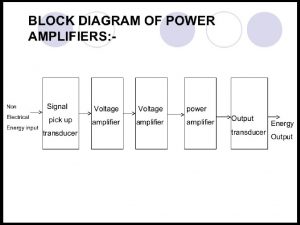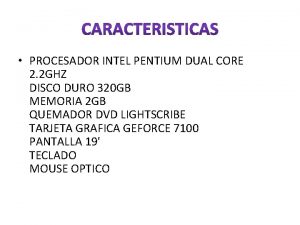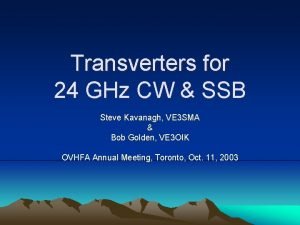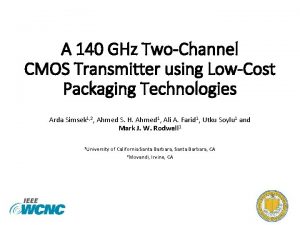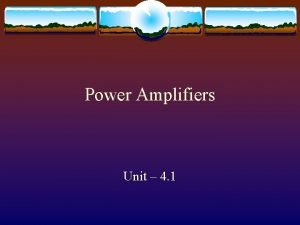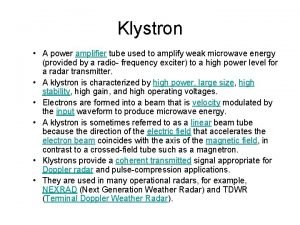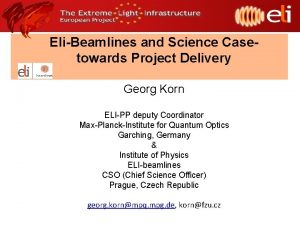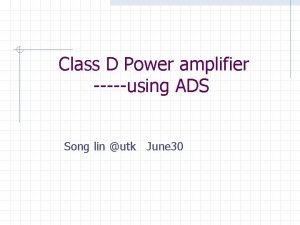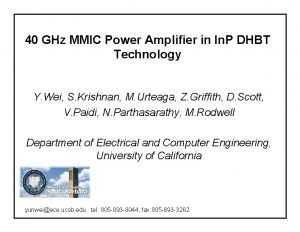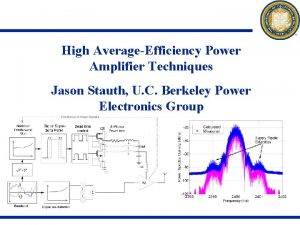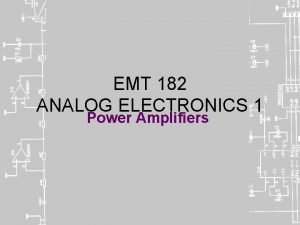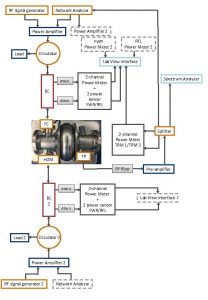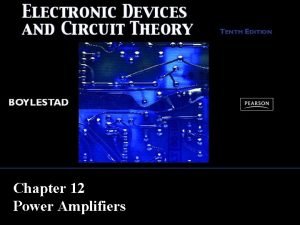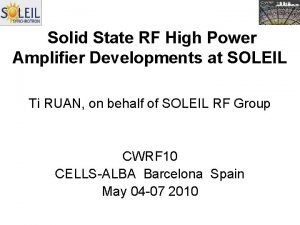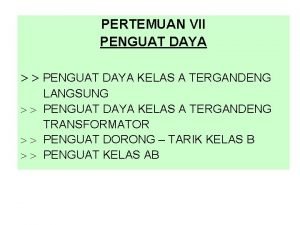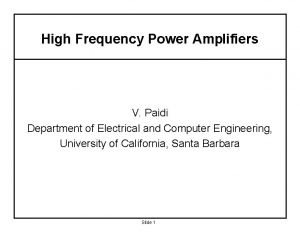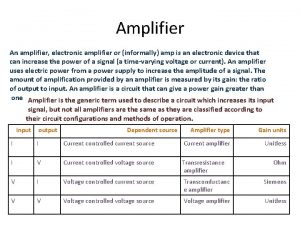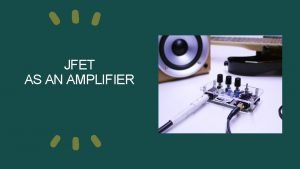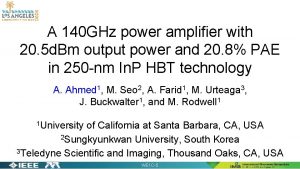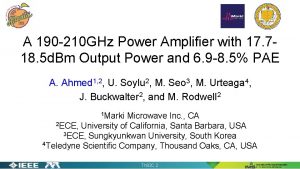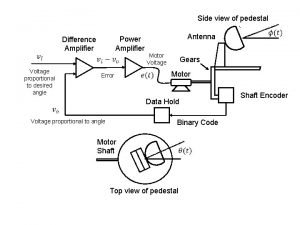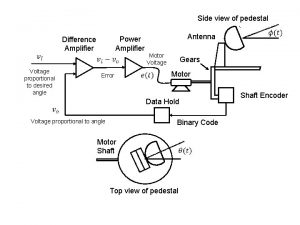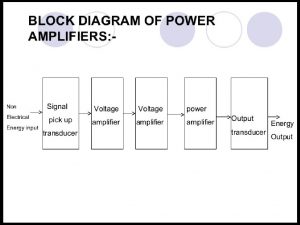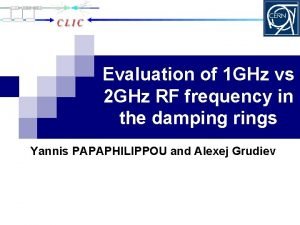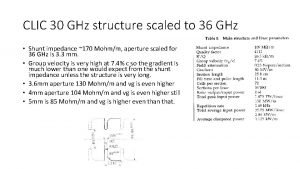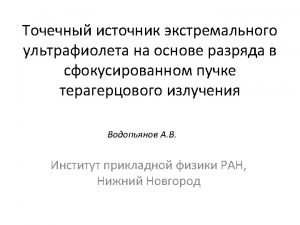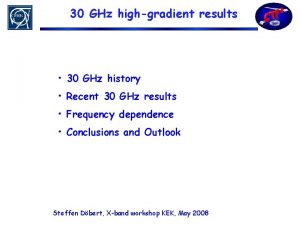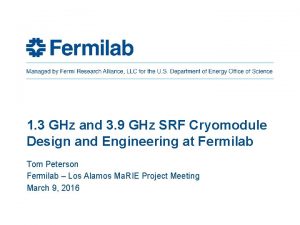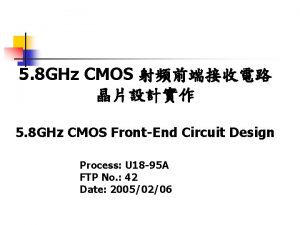40 GHz MMIC Power Amplifier in In P
















- Slides: 16

40 GHz MMIC Power Amplifier in In. P DHBT Technology Y. Wei, S. Krishnan, M. Urteaga, Z. Griffith, D. Scott, V. Paidi, N. Parthasarathy, M. Rodwell Department of Electrical and Computer Engineering, University of California yunwei@ece. ucsb. edu tel: 805 -893 -8044, fax 805 -893 -3262

LEC 2002 • • • Outline UCSB Introduction Transferred-Substrate Power DHBT Technology Circuit Design Results Conclusion

LEC 2002 • Introduction Applications for power amplifiers in Ka band Þ satellite communication systems Þ wireless LANs Þ local multipoint distribution system Þ personal communications network links and digital radio • MMIC Amplifiers in this frequency band Kwon et. al. , IEEE MTT, Vol. 48, No. 6, June. 2000 3 stage HEMT, class AB, Pout=1 W, Gain=15 d. B, PAE=28. 5%, size=9. 5 mm 2 • This Work: Single stage cascode In. P DHBT, class A, Pout=50 m. W, Gain=7 d. B, PAE=12. 5% size=0. 42 mm 2

Transferred-Substrate HBT MMIC fabrication

MBE DHBT layer structure collector substrate In. P 1 E 16 Si 2500 Å Multiple stop etch layers Buffer layer 2500 Å base Grade 1 E 16 Si 480 Å In. P 2 E 18 Si 20 Å Band profile at Vbe=0. 7 V, Vce=1. 5 V emitter In. Ga. As 1 E 19 Si 500 Å Grade 1 E 19 Si 200 Å In. P 1 E 19 Si 900 Å In. P 8 E 17 Si 300 Å Grade 8 E 17 Si 233 Å Grade 2 E 18 Be 67 Å In. Ga. As 4 E 19 Be 400 Å In. Ga. As base 3000 Å In. P collector

Small-area T. S. DHBTs have high cutoff frequencies. UCSB Sangmin Lee fmax = 462 GHz, ft = 139 GHz Vce(sat) ~1 V at 1. 8 m. A/ m 2 BVCEO = 8 V at JE =0. 4 m. A/ m 2

ARO MURI Design difficulties with large-area power DHBTs UCSB Yun Wei Current hogging in multi-finger DHBT: contact Si. N emitter base poly collector BCB Metal strip Ic Ic Temperature BCB Au Via Initial current temperature Steady stateand current and temperature distribution when thermally stable Thermal instability further increases current non-uniformity thermal feedback further increases current non-uniformity K<1 for thermal stability → must add emitter ballast resistance Distributed base feed resistance: base feed sheet resistance: s= 0. 3 / Metal 1 Emitter contact significant for > 8 um emitter finger length 0. 08 m Base contact Large Area HBTs: big Ccb, small Rbb, ® even small excess Rbb substantially reduces fmax

ARO MURI First Attempt at Multi-finger DHBTs: Poor Performance Due to Thermal Instability UCSB Yun Wei thermally driven current instability ® b collapse 8 finger common emitter DHBT Emitter size: 16 um x 1 um Ballast resistor (design): 9 Ohm/finger low fmax due to premature Kirk effect (current hogging) excess base feed resistance Jc=5 e 4 A/cm 2 Vce=1. 5 V

ARO MURI Large Current High Breakdown Voltage Broadband In. P DHBT 8 -finger DHBT 8 x (1 m x 16 m emitter ) 8 x (2 m x 20 m collector ) 2 nd-level base feed metal Key Improvements 8 Ohm ballast per emitter finger 2 nd-level base feed metal UCSB Yun Wei emitter Flip chip Device Performance fmax>330 GHz, Vbrceo>7 V, Jmax>1 x 105 A/cm 2 100 m. A, 3. 6 Volt device Ballast resistor collector

ARO MURI UCSB HBT power amplifier-why cascode? Yun Wei Advantages: common-base stage has large Vce → large output power common-emitter-stage has low Vce → small Rballast required → maintains large available power gain Disadvantage inductance of base bypass capacitor even small L greatly degrades gain IB 1 + Vce 2 IE 2 + Vce 1 IE 1 Rballast radial stub capacitor * R. Ramachandran and A. F. Podell "Segmented cascode HBT for microwave-frequency power amplifiers"

ARO MURI UCSB In. P TS DHBT Power Amplifier Design Yun Wei Imax 0. 018 0. 016 0. 014 Ic (A) 0. 012 0. 010 0. 008 0. 006 0. 004 Vsat 0. 002 0. 000 /4 0. 0 0. 5 1. 0 1. 5 2. 0 VCE_BR 2. 5 3. 0 3. 5 4. 0 Vce (V) Optimum admittance match /4 Input match Low frequency stabilization 8 finger cascode Inter-stage DC bias 4. 5 5. 0 5. 5 6. 0 6. 5 7. 0

ARO MURI 40 GHz 128 m 2 power amplifier UCSB Yun Wei cascode PA f 0=40 GHz BW 3 d. B=16 GHz GT=7 d. B P 1 d. B=14 d. Bm Psat=17 d. Bm @ 4 d. B gain 0. 6 mm x 0. 7 mm, AE=128 mm 2

ARO MURI W band power amplifiers in TS In. P DHBT technology Bias: Ic=78 m. A, Vce=3. 6 V UCSB Yun Wei common base PA f 0=85 GHz BW 3 d. B=28 GHz GT=8. 5 d. B P 1 d. B=14. 5 d. Bm Psat=16 d. Bm, associated gain: 4. 5 d. B 0. 5 mm x 0. 4 mm, AE=128 mm 2 Y. Wei et al, 2002 IEEE MTT-S symposium

ARO MURI W band power amplifiers in TS In. P DHBT technology Bias: Ic=40 m. A, Vce=3. 5 V UCSB Yun Wei cascode PA f 0=90 GHz BW 3 d. B=20 GHz GT=8. 2 d. B P 1 d. B=9. 5 d. Bm Psat=12. 5 d. Bm, associated gain: 4 d. B 0. 5 mm x 0. 4 mm, AE=64 mm 2 Y. Wei et al, 2002 IEEE MTT-S symposium

LEC 2002 Continuing work Higher-current DHBTs for increased mm-wave output power 250 GHz fmax, Ic, max=240 m. A, thermally stable at 200 m. A bias at Vce=3. 2 Volts → suitable for W-band ~150 m. W power amplifiers W-band DHBT power amplifiers designs for > 100 m. W saturated output power now being tested Results to be reported subsequently… UCSB Yun Wei

LEC 2002 Conclusions • 40 GHz MMIC power amplifier in In. P DHBT technology 7 d. B power gain and 14 d. Bm output power at 1 d. B compression. 17 d. Bm (50 m. W) saturated output power 12. 5% peak power added efficiency Future work: higher power DHBT power amplifiers at W-band above lumped 4 -finger topology, longer emitter fingers, power combining G-band (140 -220 GHz) DHBT power amplifiers Acknowledgement Work funded by ARO-MURI program under contract number PC 249806. UCSB Yun Wei
 Difference between power and voltage amplifier
Difference between power and voltage amplifier Intel pentium 2 ghz
Intel pentium 2 ghz 220 mhz transverter
220 mhz transverter From 12 to 140 ghz
From 12 to 140 ghz Active power reactive power apparent power
Active power reactive power apparent power Classification of power amplifiers
Classification of power amplifiers Klystron power amplifier
Klystron power amplifier Georg korn
Georg korn Ad power amplifier
Ad power amplifier Hbt power amplifier
Hbt power amplifier Jason stauth
Jason stauth Emt amplifier
Emt amplifier Rfl generator
Rfl generator Series fed class a amplifier
Series fed class a amplifier Solid state high power amplifier
Solid state high power amplifier Push pull class b power amplifier
Push pull class b power amplifier Hbt power amplifier
Hbt power amplifier
